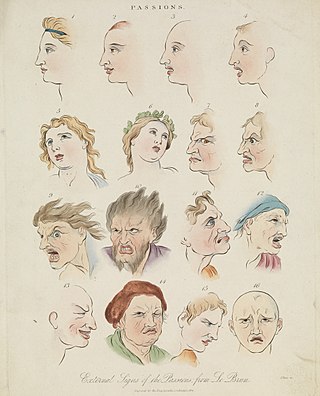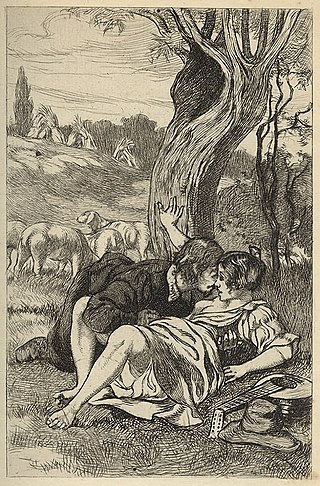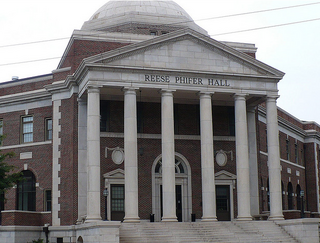Related Research Articles

Emotions are mental states brought on by neurophysiological changes, variously associated with thoughts, feelings, behavioral responses, and a degree of pleasure or displeasure. There is no scientific consensus on a definition. Emotions are often intertwined with mood, temperament, personality, disposition, or creativity.

Arousal is the physiological and psychological state of being awoken or of sense organs stimulated to a point of perception. It involves activation of the ascending reticular activating system (ARAS) in the brain, which mediates wakefulness, the autonomic nervous system, and the endocrine system, leading to increased heart rate and blood pressure and a condition of sensory alertness, desire, mobility, and reactivity.

Curiosity is a quality related to inquisitive thinking such as exploration, investigation, and learning, evident in humans and animals. Curiosity is associated with all aspects of human development, from which derives the process of learning and desire to acquire knowledge and skill.
Motivational salience is a cognitive process and a form of attention that motivates or propels an individual's behavior towards or away from a particular object, perceived event or outcome. Motivational salience regulates the intensity of behaviors that facilitate the attainment of a particular goal, the amount of time and energy that an individual is willing to expend to attain a particular goal, and the amount of risk that an individual is willing to accept while working to attain a particular goal.
The two-factor theory of emotion states that emotion is based on two factors: physiological arousal and cognitive label. The theory was created by researchers Stanley Schachter and Jerome E. Singer. According to the theory, when an emotion is felt, a physiological arousal occurs and the person uses the immediate environment to search for emotional cues to label the physiological arousal. This can sometimes cause misinterpretations of emotions based on the body's physiological state. When the brain does not know why it feels an emotion it relies on external stimulation for cues on how to label the emotion.
Opponent-process theory is a psychological and neurological model that accounts for a wide range of behaviors, including color vision. This model was first proposed in 1878 by Ewald Hering, a German physiologist, and later expanded by Richard Solomon, a 20th-century psychologist.

Affect, in psychology, refers to the underlying experience of feeling, emotion, attachment, or mood. In psychology, "affect" refers to the experience of feeling or emotion. It encompasses a wide range of emotional states and can be positive or negative. Affect is a fundamental aspect of human experience and plays a central role in many psychological theories and studies. It can be understood as a combination of three components: emotion, mood, and affectivity. In psychology, the term "affect" is often used interchangeably with several related terms and concepts, though each term may have slightly different nuances. These terms encompass: emotion, feeling, mood, emotional state, sentiment, affective state, emotional response, affective reactivity, disposition. Researchers and psychologists may employ specific terms based on their focus and the context of their work.
Media psychology is the branch and specialty field in psychology that focuses on the interaction of human behavior with media and technology. Media psychology is not limited to mass media or media content; it includes all forms of mediated communication and media technology-related behaviors, such as the use, design, impact, and sharing behaviors. This branch is a relatively new field of study because of advancement in technology. It uses various methods of critical analysis and investigation to develop a working model of a user's perception of media experience. These methods are used for society as a whole and on an individual basis. Media psychologists are able to perform activities that include consulting, design, and production in various media like television, video games, films, and news broadcasting. Media psychologists are not considered to be those who are featured in media, rather than those who research, work or contribute to the field. Mediacology is a new term used as a collaborative word of Media and Psychology.

Stanley Schachter was an American social psychologist best known for his development of the two factor theory of emotion in 1962 along with Jerome E. Singer. In his theory he states that emotions have two ingredients: physiological arousal and a cognitive label. A person's experience of an emotion stems from the mental awareness of the body's physical arousal and the explanation one attaches to this arousal. Schachter also studied and published many works on the subjects of obesity, group dynamics, birth order and smoking. A Review of General Psychology survey, published in 2002, ranked Schachter as the seventh most cited psychologist of the 20th century.
Appraisal theory is the theory in psychology that emotions are extracted from our evaluations of events that cause specific reactions in different people. Essentially, our appraisal of a situation causes an emotional, or affective, response that is going to be based on that appraisal. An example of this is going on a first date. If the date is perceived as positive, one might feel happiness, joy, giddiness, excitement, and/or anticipation, because they have appraised this event as one that could have positive long-term effects, i.e. starting a new relationship, engagement, or even marriage. On the other hand, if the date is perceived negatively, then our emotions, as a result, might include dejection, sadness, emptiness, or fear. Reasoning and understanding of one's emotional reaction becomes important for future appraisals as well. The important aspect of the appraisal theory is that it accounts for individual variability in emotional reactions to the same event.
In psychology, desensitization is a treatment or process that diminishes emotional responsiveness to a negative, aversive, or positive stimulus after repeated exposure. Desensitization can also occur when an emotional response is repeatedly evoked when the action tendency associated with the emotion proves irrelevant or unnecessary. The process of desensitization was developed by psychologist Mary Cover Jones and is primarily used to assist individuals in unlearning phobias and anxieties. Desensitization is a psychological process where a response is repeatedly elicited in circumstances where the emotion's propensity for action is irrelevant. Joseph Wolpe (1958) developed a method of a hierarchal list of anxiety-evoking stimuli in order of intensity, which allows individuals to undergo adaptation. Although medication is available for individuals with anxiety, fear, or phobias, empirical evidence supports desensitization with high rates of cure, particularly in clients with depression or schizophrenia. Wolpe's "reciprocal inhibition" desensitization process is based on well-known psychology theories such as Hull's "drive-reduction" theory and Sherrington's concept of "reciprocal inhibition." Individuals are gradually exposed to anxiety triggers while using relaxation techniques to reduce anxiety. It is an effective treatment for anxiety disorders.
Mood management theory posits that the consumption of messages, particularly entertaining messages, is capable of altering prevailing mood states, and that the selection of specific messages for consumption often serves the regulation of mood states. Mood management theory now belongs to a larger group of theoretical approaches which speak on media content and how it plays a role in mood management. Mood optimization is a current affective sate of media mood management.
In psychology, misattribution of arousal is the process whereby people make a mistake in assuming what is causing them to feel aroused. For example, when actually experiencing physiological responses related to fear, people mislabel those responses as romantic arousal. The reason physiological symptoms may be attributed to incorrect stimuli is because many stimuli have similar physiological symptoms such as increased blood pressure or shortness of breath.
Affect displays are the verbal and non-verbal displays of affect (emotion). These displays can be through facial expressions, gestures and body language, volume and tone of voice, laughing, crying, etc. Affect displays can be altered or faked so one may appear one way, when they feel another. Affect can be conscious or non-conscious and can be discreet or obvious. The display of positive emotions, such as smiling, laughing, etc., is termed "positive affect", while the displays of more negative emotions, such as crying and tense gestures, is respectively termed "negative affect".
Emotional self-regulation or emotion regulation is the ability to respond to the ongoing demands of experience with the range of emotions in a manner that is socially tolerable and sufficiently flexible to permit spontaneous reactions as well as the ability to delay spontaneous reactions as needed. It can also be defined as extrinsic and intrinsic processes responsible for monitoring, evaluating, and modifying emotional reactions. Emotional self-regulation belongs to the broader set of emotion regulation processes, which includes both the regulation of one's own feelings and the regulation of other people's feelings.

Sexual arousal describes the physiological and psychological responses in preparation for sexual intercourse or when exposed to sexual stimuli. A number of physiological responses occur in the body and mind as preparation for sexual intercourse, and continue during intercourse. Male arousal will lead to an erection, and in female arousal, the body's response is engorged sexual tissues such as nipples, clitoris, vaginal walls, and vaginal lubrication.
Emotion perception refers to the capacities and abilities of recognizing and identifying emotions in others, in addition to biological and physiological processes involved. Emotions are typically viewed as having three components: subjective experience, physical changes, and cognitive appraisal; emotion perception is the ability to make accurate decisions about another's subjective experience by interpreting their physical changes through sensory systems responsible for converting these observed changes into mental representations. The ability to perceive emotion is believed to be both innate and subject to environmental influence and is also a critical component in social interactions. How emotion is experienced and interpreted depends on how it is perceived. Likewise, how emotion is perceived is dependent on past experiences and interpretations. Emotion can be accurately perceived in humans. Emotions can be perceived visually, audibly, through smell and also through bodily sensations and this process is believed to be different from the perception of non-emotional material.
Expressive suppression is defined as the intentional reduction of the facial expression of an emotion. It is a component of emotion regulation.
In cognitive psychology, the affect-as-information hypothesis, or 'approach', is a model of evaluative processing, postulating that affective feelings provide a source of information about objects, tasks, and decision alternatives. A goal of this approach is to understand the extent of influence that affect has on cognitive functioning. It has been proposed that affect has two major dimensions, namely affective valence and affective arousal, and in this way is an embodied source of information. Affect is thought to impact three main cognitive functions: judgement, thought processing and memory. In a variety of scenarios, the influence of affect on these processes is thought to be mediated by its effects on attention. The approach is thought to account for a wide variety of behavioural phenomena in psychology.

Dolf Zillmann is dean emeritus, and professor of information sciences, communication and psychology at the University of Alabama (UA). Zillmann predominantly conducted research in media psychology, a branch of psychology focused on the effects of media consumption on human affect, developing and expanding a range of theories within media psychology and communication. His work centred on the relation between aggression, emotion, and arousal through media consumption, predominantly in pornography and violent genres of movie and television. His research also includes the effects of music consumption, video games, and sports.
References
- 1 2 3 4 5 6 7 8 9 10 11 12 13 14 15 16 17 18 19 20 21 22 23 24 25 26 27 28 29 30 31 32 33 Bryant, J.; Miron, D. (2003-05-14). Bryant, Jennings; Roskos-Ewoldsen, David R.; Cantor, Joanne (eds.). Communication and Emotion: Essays in honor of Dolf Zillmann. pp. 31–59. doi:10.4324/9781410607584. ISBN 9781410607584.
- ↑ Tannenbaum, Percy H.; Zillmann, Dolf (1975), "Emotional Arousal in the Facilitation of Aggression Through Communication", Advances in Experimental Social Psychology, Elsevier, pp. 149–192, retrieved 2023-12-12
- 1 2 3 4 5 6 Branscombe, Nyla R. (June 1985). "Effects of hedonic valence and physiological arousal on emotion: A comparison of two theoretical perspectives". Motivation and Emotion. 9 (2): 153–169. doi:10.1007/bf00991573. ISSN 0146-7239. S2CID 143465446.
- 1 2 3 4 5 6 7 8 9 10 11 12 13 14 15 16 17 18 19 20 21 22 23 24 25 Zillmann, D. (1983). Transfer of excitation in emotional behavior. In J. T. Cacioppo & R. E. Petty (Eds.), Social psychophysiology: A sourcebook. New York: Guilford Press. pp. (pp. 215–240).
- 1 2 Kurtz, Lester (2008), "Preface", Encyclopedia of Violence, Peace, & Conflict, Elsevier, pp. xix–xxv, doi:10.1016/b978-012373985-8.09008-5, ISBN 9780123739858 , retrieved 2023-12-12
- 1 2 Timmerman, Lindsay M.; Allen, Mike; Jorgensen, Jill; Herrett-Skjellum, Jennifer; Kramer, Michael R.; Ryan, Daniel J. (2008-08-20). "A Review and Meta-Analysis Examining the Relationship of Music Content with Sex, Race, Priming, and Attitudes". Communication Quarterly. 56 (3): 303–324. doi:10.1080/01463370802240932. ISSN 0146-3373. S2CID 145625741.
- 1 2 3 Zillmann, Dolf (2021-02-25). Connections between Sexuality and Aggression. doi:10.4324/9781315785295. ISBN 9781315785295. S2CID 141764281.
- 1 2 3 Zillmann, D. (2006). "Dramaturgy for emotions from fictional narration". In J. Bryant & P. Vorderer (Eds.), Psychology of Entertainment: (pp. 215–238).
- 1 2 3 Tannenbaum, Percy H.; Zillmann, Dolf (1975), Emotional Arousal in the Facilitation of Aggression Through Communication, Advances in Experimental Social Psychology, vol. 8, Elsevier, pp. 149–192, doi:10.1016/s0065-2601(08)60250-6, ISBN 9780120152087 , retrieved 2023-12-12
- 1 2 Russell, James A; Mehrabian, Albert (1977-09-01). "Evidence for a three-factor theory of emotions". Journal of Research in Personality. 11 (3): 273–294. doi:10.1016/0092-6566(77)90037-X. ISSN 0092-6566.
- 1 2 3 4 5 6 Bunce, Scott C.; Larsen, Randy J.; Cruz, Maribel (November 1993). "Individual differences in the excitation transfer effect". Personality and Individual Differences. 15 (5): 507–514. doi:10.1016/0191-8869(93)90333-x. hdl: 2027.42/30488 . ISSN 0191-8869.
- 1 2 3 4 5 Cantor, Joanne R.; Zillmann, Dolf; Bryant, Jennings (1975). "Enhancement of experienced sexual arousal in response to erotic stimuli through misattribution of unrelated residual excitation". Journal of Personality and Social Psychology. 32 (1): 69–75. doi:10.1037/h0076784. ISSN 1939-1315. PMID 1206469.
- 1 2 3 4 Zillmann, Dolf; Bryant, Jennings (1974). "Effect of residual excitation on the emotional response to provocation and delayed aggressive behavior". Journal of Personality and Social Psychology. 30 (6): 782–791. doi:10.1037/h0037541. ISSN 1939-1315. PMID 4443894.
- ↑ Zillmann, Dolf, ed. (2018-12-07), "Attribution and Misattribution of Excitatory Reactions", New Directions in Attribution Research, Psychology Press, pp. 335–368, doi:10.4324/9780203780978-15, ISBN 978-0-203-78097-8, S2CID 239497968 , retrieved 2023-12-12
- 1 2 3 Miller, K. (2001). Communication Theories: Perspectives, Processes, and Contexts (1st ed.). McGraw-Hill Humanities/Social Sciences/Languages.
- 1 2 3 Schachter, Stanley (1964), The Interaction of Cognitive and Physiological Determinants of Emotional State, Advances in Experimental Social Psychology, vol. 1, Elsevier, pp. 49–80, doi:10.1016/s0065-2601(08)60048-9, ISBN 9780120152018 , retrieved 2023-12-15
- 1 2 Bee, Colleen C.; Madrigal, Robert (April 2012). "It's Not Whether You Win or Lose; It's How The Game is Played". Journal of Advertising. 41 (1): 47–58. doi:10.2753/JOA0091-3367410104. ISSN 0091-3367. S2CID 146864082.
- 1 2 Cummins, R. Glenn; Berke, Collin K. (2017-12-01). "Excitation Transfer via Instant Replay in the Microstructure of Broadcast Sport". International Journal of Sport Communication. 10 (4): 468–486. doi:10.1123/ijsc.2017-0061. ISSN 1936-3915.
- 1 2 "Affect, Mood, and Emotion as Determinantsof Selective Exposure", Selective Exposure To Communication, Routledge, pp. 164–197, 2013-07-04, doi:10.4324/9780203056721-13, ISBN 978-0-203-05672-1 , retrieved 2023-12-15
This article needs additional or more specific categories .(December 2023) |